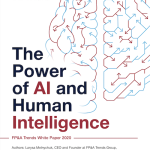To achieve FP&A transformation, organisations must master the soft dimensions that underpin the process and culture...
 The COVID-19 crisis has exponentially increased the volatility and uncertainty in the world’s political and economic environment. It has accentuated the need for agility in business planning and decision-making processes. There are increased expectations on FP&A teams to go beyond just finance and support the entire organisation with their storytelling and analytics. Gartner called this process Extended Planning and Analysis (xP&A).
The COVID-19 crisis has exponentially increased the volatility and uncertainty in the world’s political and economic environment. It has accentuated the need for agility in business planning and decision-making processes. There are increased expectations on FP&A teams to go beyond just finance and support the entire organisation with their storytelling and analytics. Gartner called this process Extended Planning and Analysis (xP&A).
However, at the same time, increased cost pressures are creating the need for smaller teams and remote-working arrangements. FP&A teams are in a challenging spot. The only way to keep up with the increased demand is to embrace FP&A digitisation, which has many shapes and forms.
This article will look at some of the trends and benefits of a digitised FP&A Business Partnering team.
1. Outsourcing Business Partnering
Until now, the FP&A function remained relatively safe from outsourcing due to its high level of Business Partnering. To truly partner with the business, one needs to stay close to the business, understand the on-ground realities and provide real-time decision-making support. As entire teams work remotely today, this paradigm has shifted significantly.
Organisations have now acknowledged that there may be some parts of the current FP&A Business Partner role and its processes that can be successfully outsourced. For instance, Rolling Forecasts and routine monthly analysis of actual vs. budget can be easily outsourced. If FP&A Business Partnering processes are digitised, organisations can successfully outsource these functions and reap huge cost advantages.
This requires adopting technologies that enable seamless communication between geographically distant teams and tools that enable remote FP&A Business Partners to keep abreast of all business developments. This can be achieved through collaborative planning technologies, real-time dashboards and regular joint reviews.
2. Improved Forecasting and Analytics
Today, analytics capabilities have evolved beyond the traditional standard spreadsheets of FP&A. The digitisation process of FP&A should leverage evolving technologies such as Robotic Process Automation (RPA), Predictive Analytics and Artificial Intelligence (AI)/Machine Learning (ML) to improve forecasting and analysis.
Robotic Process Automation (RPA) can help automate repetitive tasks traditionally performed by humans so that human effort can be focused on higher value-added tasks.
Predictive Analytics and ML can be leveraged to predict customer behaviour (such as churn and purchase trends), identify similar customers for targeting and create digital forecasts that are touchless and very accurate.
AI/ML can transform traditional FP&A departments when combined with human intelligence and effective processes. One of the most impressive examples is Microsoft’s AI revenue forecast process. Microsoft, one of the biggest companies in the world, can forecast its revenue in real-time by geographical location, product and segment. The company demonstrates that it is possible even in such a complex and diversified organisation.
Even small organisations can reap the benefits of these analytics and Machine Learning advances since multiple off-the-shelf product solutions and third-party service providers exist.
However, it is important to remember that success stories would not be possible without good processes in place. The success formula for any analytical journey combines human intelligence, good processes and Artificial Intelligence. FP&A Business Partners have leading roles to play in these transformational journeys.
The 2022 FP&A Trends Survey identified that only 33% of an FP&A team’s time is spent on value-add activities such as insight generation and decision support. The digital transformation journey helps to free up lots of time and allows team members to focus on the true xP&A Business Partner role.
3. Storytelling with Data Visualisation
FP&A Business Partnering does not end with forecasting or analysis. There is a wide range of data visualisation tools that FP&A Business Partners can adopt to improve their communication with different stakeholders.
In a world of information overload, telling the story behind the numbers is a very valuable skill. A Business Partner needs to use data visualisation techniques to communicate insights and direct key stakeholders towards making better decisions.
Steps Toward a Digitised FP&A Business Partner Team
Digitised FP&A Business Partners can benefit an organisation immensely if managed well. Below are the steps that leadership need to start with:
- Define clear digitisation goals:What does digitisation mean for the organisation? What objectives are we seeing to achieve through digitisation? For example, cost optimisation through outsourcing or restructuring and FP&A transformation into a self-financing function.
- Prepare a roadmap with an overall target timeline: Identify the key steps to achieve the targets. For example, decide which technologies or tools are needed, whether to develop technologies in-house or outsource them and which processes to digitise first and integrate processes across functions.
- Identify key stakeholders and process owners: The digitisation process involves a cost. It is an investment that will eventually reap a strong return (ROI) but requires upfront funding. Hence, a critical first step is identifying budget sponsors. In addition, it is vital to identify the right process owners that will drive the transformation. FP&A Business Partners need to form a strong partnership with the Chief Information Officer (CIO) and their team to help the journey.
FP&A Business Partnering, at its core, is all about providing actionable insight to business management that helps drive better decisions and produce more attractive financial outcomes. FP&A has matured as a function quite significantly since the traditional budgeting days. Embracing technology is the next step that will take the FP&A function to the next level.
This article was first published on the Vena blog.
Subscribe to
FP&A Trends Digest

We will regularly update you on the latest trends and developments in FP&A. Take the opportunity to have articles written by finance thought leaders delivered directly to your inbox; watch compelling webinars; connect with like-minded professionals; and become a part of our global community.





